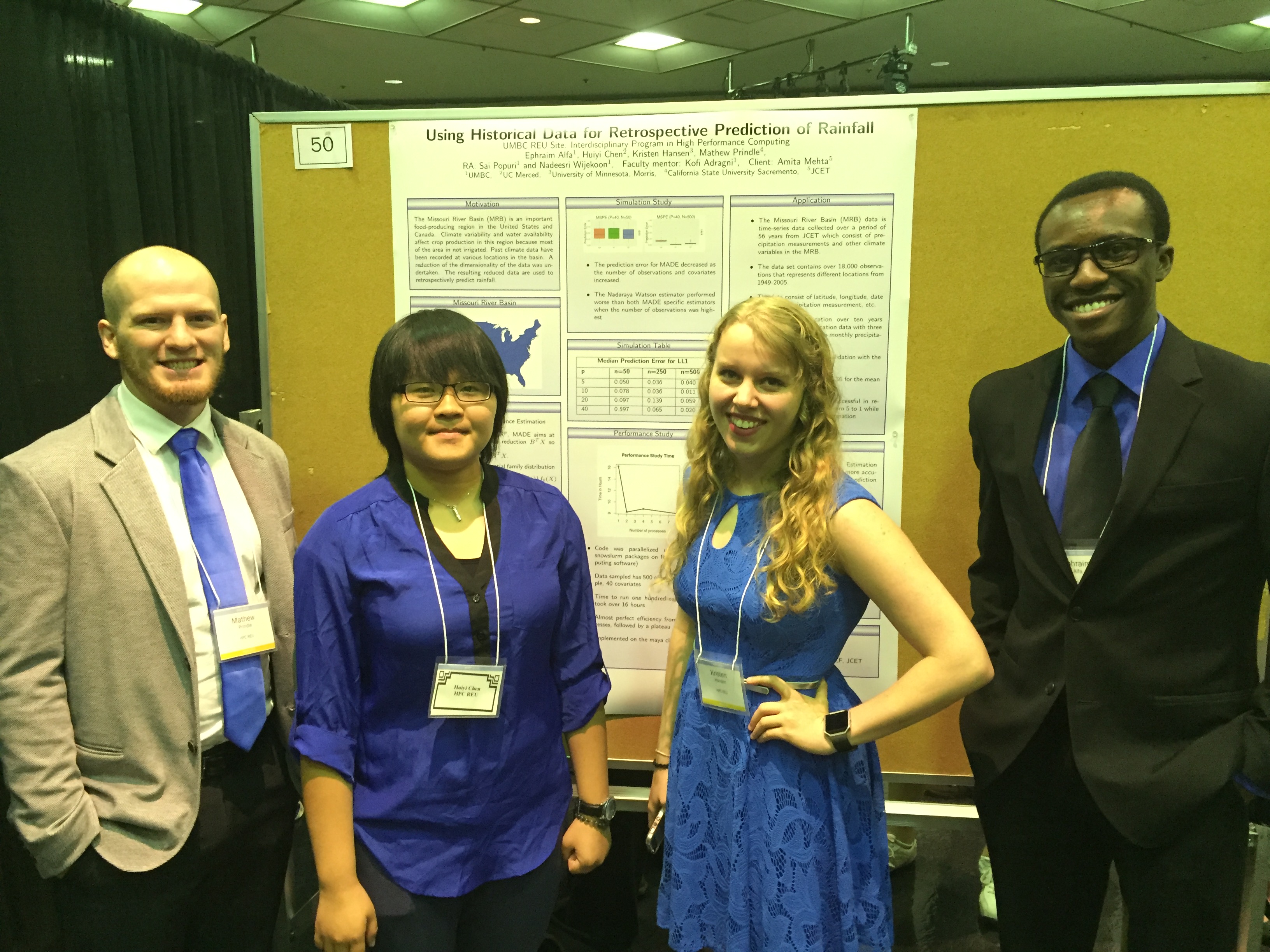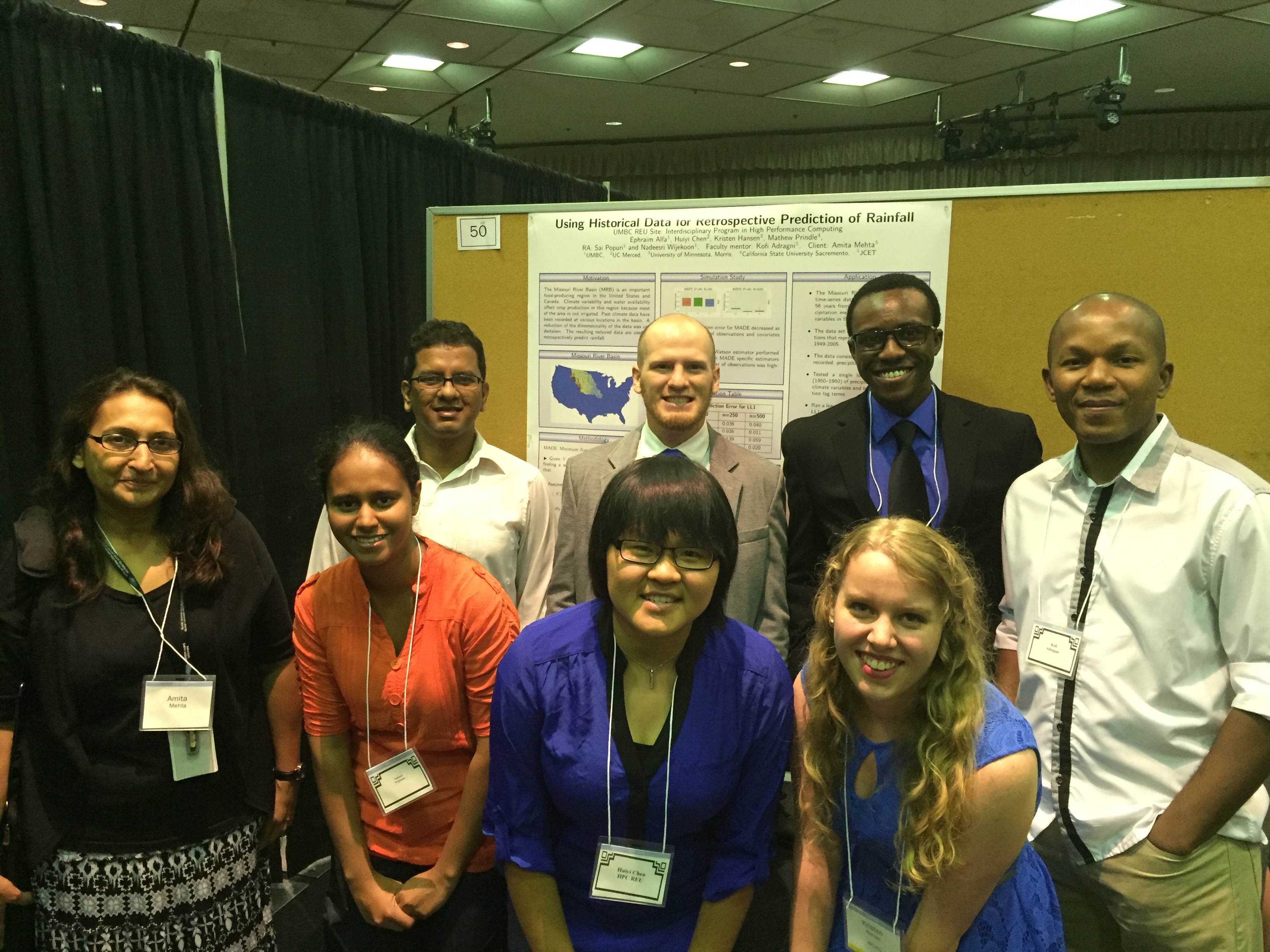| Team Members: | Ephraim Alfa1, Huiyi Chen2, Kristen Hansen3, and Mathew Prindle4 |
| Graduate Assistants: | Sai Popuri1 and Nadeesri Wijekoon1 |
| Faculty Mentor: | Kofi P. Adragni1 |
| Client: | Amita Mehta5 |
1Department of Mathematics and Statistics, University of Maryland, Baltimore County,
2Department of Mathematics, University of California, Merced,
3Department of Statistics, University of Minnesota, Morris,
4Department of Mathematics, California State University, Sacramento
5JCET and GES, University of Maryland, Baltimore County
About the Team
Kristen Hansen is a rising senior at University of Minnesota, Morris majoring in Statistics and Psychology major and minoring in Mathematics. Ephraim Alfa is a rising sophomore at UMBC majoring in Mathematics and minoring in economics. Mathew Prindle is a senior at California State University, Sacramento majoring in Mathematics. Huiyi Chen is a rising junior at University of California, Merced majoring in Applied Mathematics.
We worked with Faculty Mentor Dr. Kofi Adragni and Graduate Assistants Nadeesri Wijekoon and Sai Popuri. Our client Amita Mehta is from JCET and GES. We took on parallelizing the MADE code that was provided to us as well as running a simulation study before applying MADE to the Missouri River Basin data.
Problem
The Missouri River Basin (MRB) is an important food-producing region in the United States and Canada. Climate variability and water availability affect crop production in this region because most of the area is not irrigated. Past climate data have been recorded at 18,000 locations in the basin. We attempted to reduce the dimension of the data and retrospectively predict rainfall at a single location.
Minimum Average Deviance Estimation (MADE)
Minimum Average Deviance Estimation is a developing sufficient dimension reduction method that is an extension of Minimum Average Variance Estimation, expanded to be useful for exponential family distributions. It employs the use of local regression. It evaluated the local likelihood function to obtain the deviance function where a coefficient matrix is estimated by optimizing the deviance function over a Stiefel Manifold. The quality of the reduction is evaluated using three prediction methods namely Nadaraya Watson, which is a general sufficient dimension reduction estimator and two MADE specific estimators.
Conclusions
We used monthly precipitation data and a few other covariates to test Minimum Average Deviance Estimation (MADE) for dimension reduction and we concluded that MADE estimators are more accurate than the Nadaraya-Watson prediction estimator. We also noticed that MADE is most effective on data with many covariates and observations. However, further study is warranted for using MADE to reduce the dimensions of time series data because we tested a single location over ten years using leave one out cross validation and the prediction error was low. It is unknown if MADE would work on larger datasets and how efficient it will be.
Links
Ephraim Alfa, Huiyi Chen, Kristen Hansen, Mathew Prindle, Sai K. Popuri, Nadeesri Wijkekoon, Kofi P. Adragni, and Amita Mehta. Using Historical Data for Retrospective Prediction of Rainfall In the Midwest. Technical Report HPCF-2016-11, UMBC High Performance Computing Facility, University of Maryland, Baltimore County, 2016. (HPCF machines used: maya.). Reprint in HPCF publications list
Poster presented at the Summer Undergraduate Research Fest (SURF)
Click here to view Team 2’s project
Click here to view Team 3’s project
Click here to view Team 4’s project
Click here to view Team 5’s project
Click here to view Team 6’s project
Click here to view Team 7’s project



